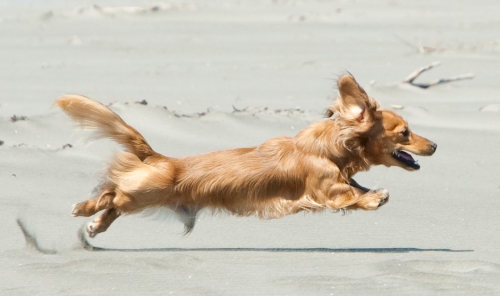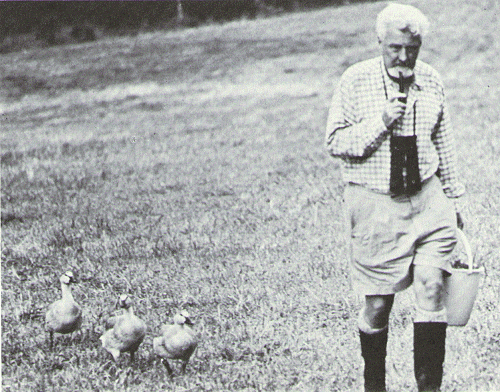
Recreating defunct breeds and strains is an old obsession in the dog world. The earliest historical record I can find of people trying to save and restore a breed occurred in the late eighteenth century, when the great “wolf-dogs” began to disappear. There was a mass scramble to find Irish wolfhounds in various parts of Ireland in order have a workable bloodline.
Of course, the Irish wolfhound was still around when it was decided to restore and preserve it. The same cannot be said for the ancient Eurasian spitz dog.
Before I begin even discussing the particulars of its reconstruction, I must make some points about the existence of this dog. The first of these is that there was probably no single ancient Eurasian spitz breed or even landrace from which all of these spitz-type dogs descend.
But it is something that makes a good romantic story.
The well-known zoologist Konrad Lorenz extolled he virtues of puppies resulting from a cross between his German shepherd dog and his chow bitch. This cross occurred when Lorenz was firmly pushing his since disproved theory that dogs were derived from two different species of wild dog. German shepherds and all of the other tractable dogs from Europe were believed to be derived primarily from golden jackals. The chow and the other extremely aloof yet extreme loyal breeds were believed to be derivatives of the wolf.
After the Second World War, German named Julius Wipfel took in a dog that had been accompanying Canadian troops. The dog was named the Canadian, and it often conjectured that he was an actual Canadian Inuit dog or something like one. This dog made a very strong impression on Wipfel. He was very different from the typical Western European dogs he had known. He was intensely loyal and protective, but he was also very intelligent. When the Canadian died, he purchased a Wolfspitz (Keeshond) bitch. Of course, she was nothing like the Canadian. She was a typical Keeshond, very friendly and quirky. (Wolfspitz is usually spelled “Wolfsspitz” in German. For my purposes, I’m dropping the possessive “s,” which looks weird in the English language.)
It was around this time that Wipfel read of Lorenz’s chow/shepherds, and he began to think. Now, this is always a dangerous thing. Wipfel had experienced life with a dog he believed to be a Canadian Inuit dog, and as is often the case, an experience with one profound dog can totally shape one’s understanding of what a dog or type of dog should be. His mind was also full of Lorenz’s dog theories.
And out of that melange of ideas, came the decision to breed the Wolfspitz with the Chow Chow. He tried to register his dogs as “wolf-chows,” but the chow and wolfspitz clubs refused.
He also got involved with Charlotte Baldamus, a woman who had become an expert in producing purebred poultry. Wipfel needed someone with practical experience to help him found his strain.
Baldamus was a follower of Robert Bakewell’s breeding philosophy. Breed “in and in” to establish desired characteristics in your line. However, after several generations of breeding “in and in,” Wipfel was warned to add new blood. He consulted with a geneticist at the Institute for Breeding and Genetics of Domestic Animals at the University of Göttingen, who told him to find some new blood soon.
It was decided that the Samoyed would be the outcross. Although I can find no evidence that the Keeshond is related to the Samoyed, they are related in original utility. Both are originally derived from herders. The Keeshond’s ancestors were the German and Dutch farm spitz, which herded stock and killed vermin. The Samoyed’s ancestors were the dogs that helped the nomadic Samoyedic people herd reindeer. The dogs do have similar temperaments, although the Samoyed is more independent. They are both generally docile animal that are often recommended as family pets.
Of course, at that time, no one was recommending the chow-chow as family pet. They were bred in China for a variety of purposes, but the most infamous reason is that they were meant to be edible. The dogs bond very strongly to just a few people and are quite protective of their families. This breed has a reputation for aggression that has since subsided in recent years.
By adding Samoyed to the line, the Eurasier’s breeders were essentially choosing to create a more docile breed than the typical chow chow of that time period.
And it worked.
It was not long before this breed became relatively popular in the German-speaking world. The breed was popularized as being based upon the work of Konrad Lorenz, who was something of a celebrity and public intellectual. This connection was made stronger when Lorenz offered his words of support to the breeding program.
Today’s Eurasier is often recommended as a family pet. It is a docile, tractable dog that bonds very strongly with its family. Although Wipfel wanted to created a dog that was something like the Canadian, he actually created something new. The growing West German middle class had a new breed to purchase for their families.
Of course, the dog was sold as a recreation of something ancient. Supposedly, a dog with Samoyed, Chow, and Keeshond blood would be something like the ancient ancestor of all three– a breed that once roamed Eurasia with bands of nomads for thousands of years.
Wipfel also had designs on producing a line of sled dogs from his breeding program. After all, he believed the Canadian was a sled dog. However, I have not heard of any major sled dog teams that use Eurasiers or Eurasier crosses. Perhaps these exist in Europe, but I have not heard of any in North America.
But whatever Wipfel wanted, the Eurasier is now a family pet. It supposedly is like those dogs of yore that once followed nomads across the continent. However, it is really a dog that was developed to live one of Europe’s most densely populated countries. It is more at home in the suburbs of Berlin and Munich than roaming those ancient steppes and forests. It is as domesticated as we are.
(More on Eurasiers here)
***
Wipfel was inspired to create his breed after experiencing life with one dog and after reading some of Konrad Lorenz’s writings. I would like to say that those influences have no effect on me, but of course, I would be in denial.
I think a lot of what influences my views on golden retrievers is my experience with one field-line golden that was very driven and very smart. She lived to retrieve. If she was called a golden retriever, that would be an understatement. There was no such thing as refusing to retrieve. The joy of doing so was reward enough for her.
She was also leggier in framed and darker in color than many goldens are today, and she possessed thinner features than one typically sees in show dogs. She was a brilliant animal, very easily trained and very well-versed in the vagaries both human and dog communication. I never once saw her fight another dog, but she did have her ways of getting them to do what she wanted. She also responded very quicky to both human words and body language.
In Lorenz’s formulation, she would have been an aureus dog, but I liked to think of her as a “golden wolf.”
I also have been influenced by the book Merle’s Door. The dog in that book is a retriever cross of some sort, and his behavior is very similar to hers, with one notable exception. He doesn’t like to retrieve at all. However, he relates to people, dogs, and other animals in much the same way as my first golden.
I suppose we dog people are always a bit influenced by romance and nostalgia. I think those influences are healthy, but they are only acceptable if they are sublimated to a simple understanding that the dog is an organism with it own needs for a healthy gene pool and its own “being presence.” I am not so sure we can call that “being presence” a mind, but it is a close approximation.
Dogs also exist within the cultural and economic conditions of their time period, which is why I don’t think we can recreate the St. John’s water dog and the Irish wolfhound probably isn’t the animal you want to use when you go to Alaska on a wolf hunt. The selective pressures that produced these animals disappear or are distorted once the exact conditions no longer exist.
I don’t think my romance and nostalgia would ever lead me to do what Julius Wipfel and his colleagues did. After all, that project cost a lot of money and took decades to perfect.
But I can’t say I’m not influenced by these same forces.
Dog people wouldn’t be much without some romance and nostalgia.
It’s just got to be kept in perspective.
Read Full Post »











